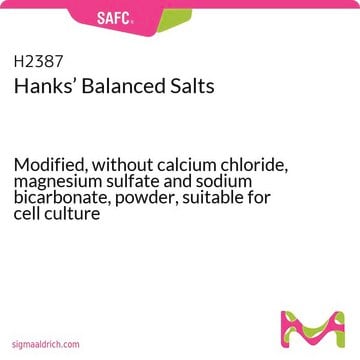H9394
Hanks′ Balanced Salt solution
Modified, with sodium bicarbonate, without calcium chloride and magnesium sulfate, liquid, sterile-filtered, suitable for cell culture
Synonym(s):
HBSS
Sign Into View Organizational & Contract Pricing
All Photos(1)
About This Item
UNSPSC Code:
12352207
NACRES:
NA.75
Recommended Products
sterility
sterile-filtered
form
liquid
technique(s)
cell culture | mammalian: suitable
impurities
endotoxin, tested
components
NaHCO3: 0.35 g/L
glucose: 1.0 g/L (Dextro)
phenol red: 0.011 g/L
shipped in
ambient
Looking for similar products? Visit Product Comparison Guide
General description
Hanks′ Balanced Salt solution is recommended for suspension cultures or whenever cell clumping is a problem.
Application
Hanks′ Balanced Salt solution has been used:
- as a component of the culture medium for culturing of mouse cortical slices
- as a component of the dissociation buffer for incubation of human-induced pluripotent stem cells (hiPSCs) and hiPSC-derived cardiomyocytes (CMs)
- for in situ perfusions of mice liver
Biochem/physiol Actions
Balanced salt solution in cell culture plays multiple roles such as, an irrigating, transporting and diluting fluid while maintaining intra- and extracellular osmotic balance, and provides cells with water and certain bulk inorganic ions essential for normal cell metabolism. It is also involved in providing a buffering system to maintain the medium within the physiological pH range (7.2-7.6) and provides the principal energy source for cell metabolism.
Storage Class Code
12 - Non Combustible Liquids
WGK
WGK 1
Flash Point(F)
Not applicable
Flash Point(C)
Not applicable
Certificates of Analysis (COA)
Search for Certificates of Analysis (COA) by entering the products Lot/Batch Number. Lot and Batch Numbers can be found on a product’s label following the words ‘Lot’ or ‘Batch’.
Already Own This Product?
Find documentation for the products that you have recently purchased in the Document Library.
Customers Also Viewed
Norma Jäppinen et al.
Nature communications, 10(1), 281-281 (2019-01-19)
Macrophages serve multiple functions including immune regulation, morphogenesis, tissue homeostasis and healing reactions. The current paradigm holds that mammary gland macrophages first arise postnatally during the prepubertal period from the bone marrow-derived monocytes. Here we delineate the origins of tissue-resident
Adrian Westhaus et al.
Human gene therapy, 31(9-10), 575-589 (2020-02-01)
Adeno-associated virus (AAV) vectors are quickly becoming the vectors of choice for therapeutic gene delivery. To date, hundreds of natural isolates and bioengineered variants have been reported. While factors such as high production titer and low immunoreactivity are important to
Pratyusha Mandal et al.
Viruses, 12(11) (2020-11-01)
Cytomegaloviruses all encode the viral inhibitor of caspase-8-induced apoptosis (vICA). After binding to this initiator caspase, vICA blocks caspase-8 proteolytic activity and ability to activate caspase-3 and/or caspase-7. In this manner, vICA has long been known to prevent apoptosis triggered
Sarah Pedretti et al.
PloS one, 14(6), e0218432-e0218432 (2019-06-21)
High density lipoprotein (HDL) protects against myocardial infarction via mechanisms that remain unclear. STAT3 (signal transducer and activator of transcription 3) plays a key role in HDL-induced cardioprotection. In the heart, microRNAs (miRNAs) are involved in ischemia reperfusion injury. We
Margret Bessadottir et al.
PloS one, 7(12), e51296-e51296 (2012-12-12)
The lichen compound usnic acid (UA) is a lipophilic weak acid that acts as a proton shuttle and causes loss of mitochondrial inner membrane potential. In the current study we show that UA treatment induced the formation of autophagosomes in
Our team of scientists has experience in all areas of research including Life Science, Material Science, Chemical Synthesis, Chromatography, Analytical and many others.
Contact Technical Service






